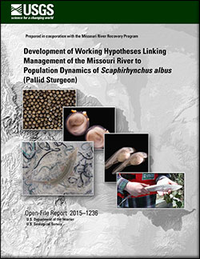Development of working hypotheses linking management of the Missouri River to population dynamics of Scaphirhynchus albus (pallid sturgeon)
Links
- Document: Report (5.03 MB pdf)
- Download citation as: RIS | Dublin Core
Abstract
This report documents a process of filtering of hypotheses that relate Missouri River Scaphirhynchus albus (pallid sturgeon) population dynamics to management actions including flow alterations, channel reconfigurations, and pallid sturgeon population augmentation. The filtering process was a partnership among U.S. Geological Survey, U.S. Army Corps of Engineers, and U.S. Fish and Wildlife Service to contribute to the Missouri River Recovery Management Plan process. The objective of the filtering process was to produce a set of hypotheses with high relevance to pallid sturgeon population dynamics and decision making on the Missouri River. The Missouri River Pallid Sturgeon Effects Analysis team filtered hundreds of potential hypotheses implicit in conceptual ecological models to develop a set of 40 candidate dominant hypotheses that were identified by experts as being important in pallid sturgeon population dynamics. Using a modified Delphi process and additional expert opinion, the team reduced this set of hypotheses to 23 working dominant hypotheses. We then matched the 23 hypotheses with management actions that could influence the biotic outcomes, resulting in as many as 176 potential effects between management actions and pallid sturgeon in the Missouri River. This number was consolidated to a candidate set of 53 working management hypotheses because some management actions applied to multiple life stages of the pallid sturgeon. We used an additional round of expert surveys to identify a set of 30 working management hypotheses. Finally, the set of working management hypotheses was filtered by the U.S. Army Corps of Engineers, Missouri River Recovery Program for actions that were within the agency’s authority and jurisdiction. This round resulted in a set of 21 hypotheses for initial modeling of linkages from management to pallid sturgeon population responses.
The initial set of candidate hypotheses provides a useful starting point for quantitative modeling and adaptive management of the river and species. We anticipate that hypotheses will change from the set of working management hypotheses as adaptive management progresses. More importantly, hypotheses that have been filtered out of our multistep process are still being considered. These filtered hypotheses are archived and if existing hypotheses are determined to be inadequate to explain observed population dynamics, new hypotheses can be created or filtered hypotheses can be reinstated.
Suggested Citation
Jacobson, R.B., Parsley, M.J., Annis, M.L., Colvin, M.E., Welker, T.L., and James, D.A., 2016, Development of working hypotheses linking management of the Missouri River to population dynamics of Scaphirhynchus albus (pallid sturgeon): U.S. Geological Survey Open-File Report 2015–1236, 33 p., https://dx.doi.org/10.3133/ofr20151236.
ISSN: 2331-1258 (online)
Study Area
Table of Contents
- Abstract
- Introduction
- Approach to Process Hypotheses Formation and Filtering
- Working Hypotheses Linking Management of the Missouri River to Population Dynamics
- Implications of the Hypothesis Filtering Process
- Summary and Conclusions
- References Cited
| Publication type | Report |
|---|---|
| Publication Subtype | USGS Numbered Series |
| Title | Development of working hypotheses linking management of the Missouri River to population dynamics of Scaphirhynchus albus (pallid sturgeon) |
| Series title | Open-File Report |
| Series number | 2015-1236 |
| DOI | 10.3133/ofr20151236 |
| Publication Date | January 20, 2016 |
| Year Published | 2016 |
| Language | English |
| Publisher | U.S. Geological Survey |
| Publisher location | Reston, VA |
| Contributing office(s) | Columbia Environmental Research Center |
| Description | v, 33 p. |
| Country | United States |
| Other Geospatial | Missouri River Basin |
| Online Only (Y/N) | Y |
| Additional Online Files (Y/N) | N |


